Letters from Lodi
An insightful and objective look at viticulture and winemaking from the Lodi
Appellation and the growers and vintners behind these crafts. Told from the
perspective of multi-award winning wine journalist, Randy Caparoso.
Winter pruning, the crucial time of the year for vineyards, old vine plantings and wine quality
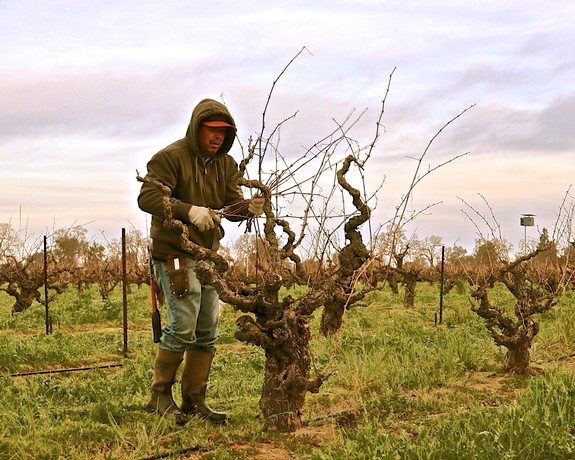
Meticulous winter pruning of the long, twisting arms of head trained, own-rooted Zinfandel first planted during the 1920s in Lodi's Clements Hills appellation.
Winter is coming
Winter, you can say, is the "quiet time" of year in wine regions around the world. Yet there is a lot going on. Not just in the wineries, where cellar hands are busy topping off barrels and getting white wines and rosés resting in tanks or wood ready for bottling. But also in the vineyards, in amongst the plants that are bereft of leaves, seemingly in the midst of a cold and continuously rain-soaked hibernation.
Consider the fact that, depending on plant spacing, there are somewhere from 900 to 1,200 grapevines per acre in most California wine regions. In Lodi, there are over 100,000 acres of planted wine grapes. This means there are over 90 million grapevines that need to be pruned during the course of each winter. If it sounds like a daunting task, it is!
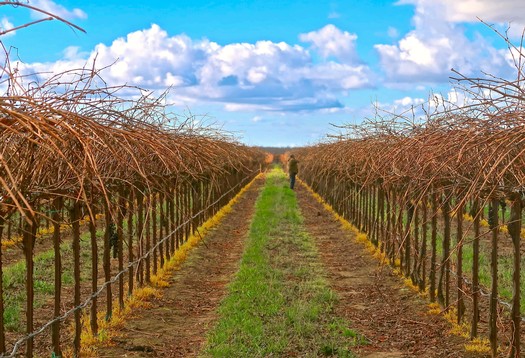
Winter pruning of trellised grapevines in Lodi's Mokelumne River AVA.
It is true that there are now machines that can help with the yearly pruning. But these machines primarily do what is called "pre-pruning," the cutting off of canes to 6-to-12-inch lengths. After the machines pass through, pruners still need to walk through the vineyards and manually attend to each and every vine; selecting the wood to take off or leave on each plant, making a decision of how many and which buds to leave in anticipation of the upcoming spring growth.
The Lodi wine region is famous, of course, for vineyards configured in the older styles: grapevines trained on single stakes, without the support of trellis wires. The vast majority of vineyards in California may be trellised, but in Lodi, there are more of these free-standing, spur-pruned vines—most of them planted over 60 years ago, plus quite a few planted over 100 years ago—than in any other region in California.
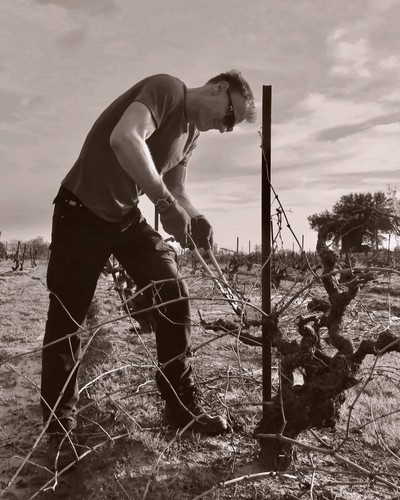
Lodi vigneron Markus Niggli pruning Prohibition era head trained Zinfandel block in Clements Hills-Lodi AVA.
As "old vines" increase in cachet in the wine industry and ever-expanding market, more and more attention is being focused on Lodi, precisely because it happens to sit on such a plethora of historic old vine plantings.
It is not possible to machine-prune older vines trained on single stakes. Each plant in an older block is configured in slightly if not drastically, different configurations. Their spurs, like the branches of trees, grow in directions and angles unique to each individual plant. The older the plant, the more unique the shape of each individual vine.
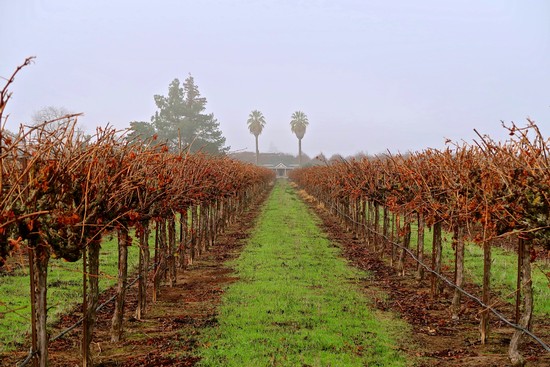
Mechanically pre-pruned trellised vineyard in Mokelumne River-Lodi AVA, awaiting follow-up of hand pruning of each individual vine.
Therefore, the thousands of acres of these head or vertical cordon-trained vines growing in Lodi must be pruned entirely by hand, from beginning to end. There are no mechanical shortcuts.
Because there are so many grapevines in a region such as Lodi, the work of pruning vineyards in Lodi has to start at least by December, and doesn't end until February or the beginning of March. The job needs to be finished by the time temperatures rise and bud break begins.
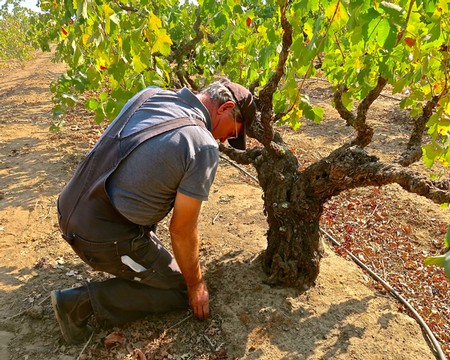
Marchelle's Greg La Follette on bended knee, paying homage to Mokelumne River-Lodi ancient vine, originally planted in the late 1880s.
Greg La Follette talks about this crucial time of year
Greg La Follette is the co-owner/winemaker of Marchelle Wines. Although he is renowned for Pinot Noir and Chardonnay grown mostly on the West Sonoma Coast, he has been sourcing grapes from Lodi's oldest vineyards—originally planted as long as 135, 138 years ago—for over twenty years.
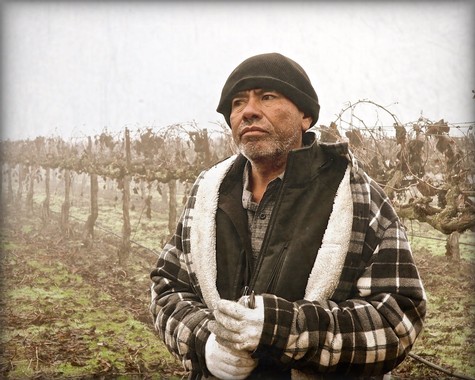
Grapevine pruner in Lodi's Mokelumne River Viticultural Area.
La Follette believes each old vine in Lodi should be approached with reverence, hat off, on bended knee. When asked what he thinks of the importance of the job of pruning old vines, he couched his thoughts in terms of the relationship between a vintner and grapevine:
I don't think most folks really understand how important simple things such as pruning are to the pure vineyardist. All the things that we love about grapevines and our attempt to try to understand them are very worthy subjects. They tell the story of who we are and who the vines are!
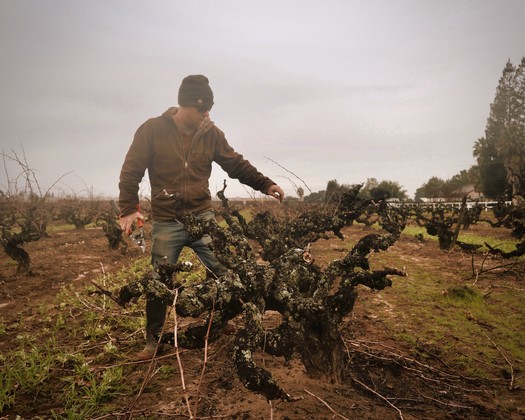
Phillips Farm's viticulturist Michael Klouda pruning head-trained old vine Zinfandel, originally planted in 1929.
Winter, to La Follette, is a time of "contemplation"—the expenditure of thought processes entailing how to bring out the best in an individual grapevine in order to achieve the best in a vineyard, which directly correlates with the best possible wine that can be made from a vineyard:
Pruning old vines, especially, is a contemplative experience that allows one to have a closer understanding of the land. To see the years of growth and development of the structure of an older vine is to have a window into the vine's past, and help partner in its future.
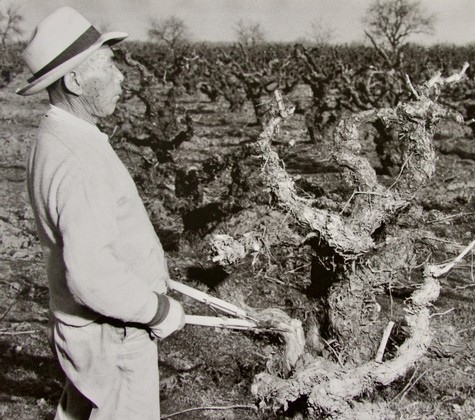
Circa-1950s photo of Japanese vineyard owner in Lodi, pruning goblet-trained Zinfandel already of advanced age.
The intrinsic nature of grapevines, La Follette reminds is to be, well, a vine—a plant originally designed by Nature to climb as far as possible, and cling to everything it can. To produce leaves and tendrils. La Follette describes that part of a vine as "vegetative strategy," which he contrasts with "reproductive strategy"—the latter activity, associated with the production of fruit, namely grape bunches.
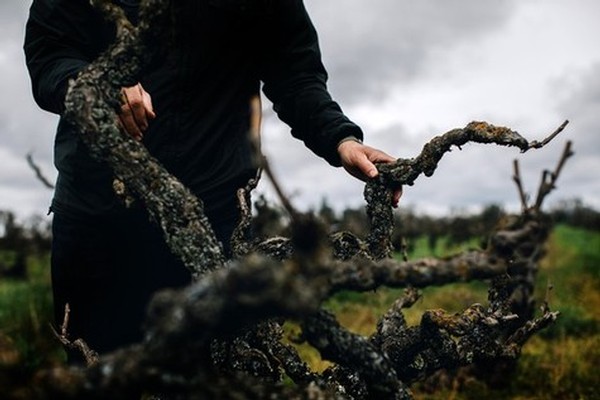
The hands of the vineyardist on just-pruned Zinfandel in Lodi. Allison Watkins Studio.
Like every living organism (including ourselves!), says La Follette, a vine's primary objective is to be "fruitful and multiply." It is how a pruner works with this intrinsic nature that determines the ultimate quality of the resulting fruit...
Grapevines are, by nature, climbing animals. To produce the best wine in a vineyard, though, they need to be given structure and discipline by the hand of the vineyardist to short-circuit their tendency to want to take part in vegetative strategy and be given a reason to embark on reproductive strategy.
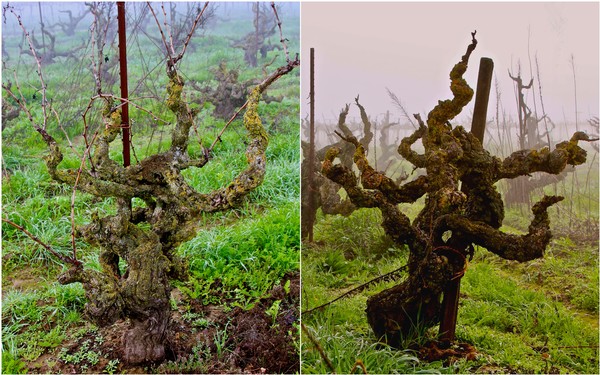
"Before and after" pruning of own-rooted Zinfandel in the ancient vine (planted in 1915) Mokelumne River-Lodi vineyard.
This is why correct pruning is so important. Getting a vine to focus primarily on reproduction starts with how it is pruned. For older vines that have already had a fair amount of structure associated with them, having been disciplined for years by the hands of pruners. there is a built-in advantage, even over trellised vines. Head-trained, spur-pruned old vines, such as the ones we work with in Lodi, start off much better positioned to follow a reproductive strategy.
The big challenge of pruning older vines, though, is the fact that each individual vine can be a bit of a jigsaw puzzle. An experienced pruner is in tune with what each vine wants to do. In turn, each vine is in tune with the land it sits on. A pruner needs to be able to make the adjustments to each vine, on every site, working hand in hand with each vineyard to achieve the best possible outcome.
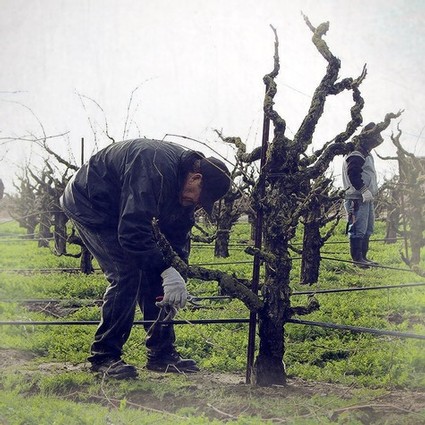
Winter pruning of old vines in Lodi, which can be back-breaking work when spurs are barely a foot off the ground.
In the end it's winemakers—which La Follette often describes as "us hose draggers"—that benefit from all the hard work put in by the grapevine pruners in the fields during the cold of winter, making it possible to produce truly interesting wines. Especially wines from old vineyards such as Lodi's, possessing sensory qualities unique to the plants, history, and human hands going into each and every site.
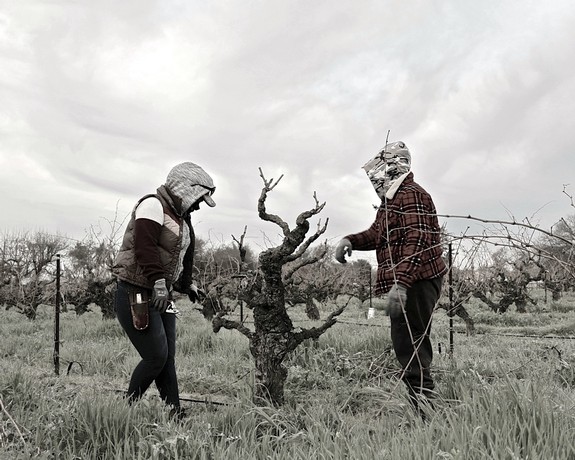
Winter pruning of old vine Zinfandel in the Historic Vineyard Society-certified Stampede Vineyard, in Lodi's Clements Hills AVA.